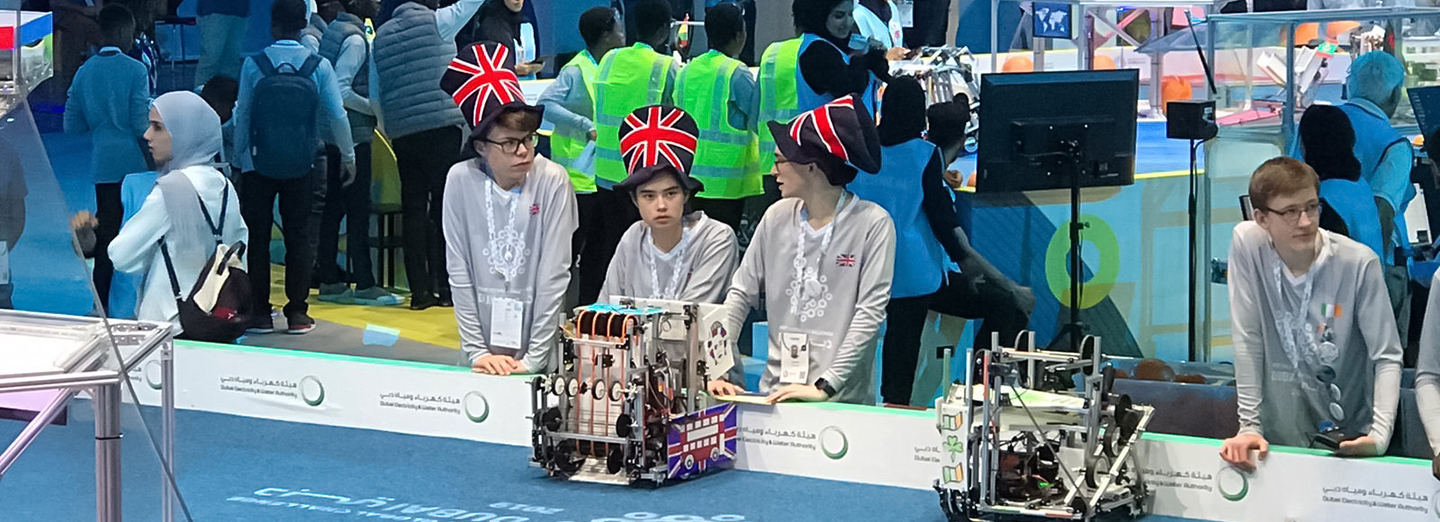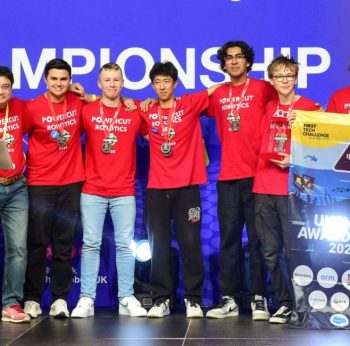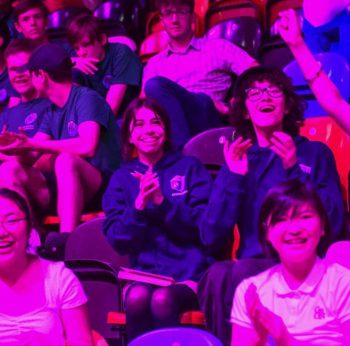
Building a strong game strategy – a lesson from team Binary Bots
Having a game strategy is critical when competing in the FIRST Tech Challenge. Not only does it help teams to focus on how they’ll score points, it also guides the robot’s design and function. Dom, from team Binary Bots 003 – who also developed this season’s strategy mission in Makerspace – shares his team’s approach to developing a strong game strategy and lessons learned from last season.
. . .
Waiting
Our kickoff began way, way too early. After finishing a robotics competition over the summer, I had been looking forward to the start of the FIRST Tech Challenge season for weeks. When September 8 finally rolled around, I rushed to Patrick’s apartment in fear of being late for the game announcement. Patrick is our programmer, and because our team isn’t tied to a school, we spent the season building our robot on his dining room table (much to the dismay of his cats).
I clearly wasn’t alone in my excitement, as several members of my team had beaten me to Patrick’s, despite the fact that the kick-off event in the US didn’t begin live streaming for another half hour. By the time that the rest of the team showed up, we had amassed a full table of snacks (our team lives to eat), and it was nearly time for the livestream to begin.
Watching
I’m no stranger to a FIRST game reveal video, but even after three years I find them difficult to comprehend when watching them for the first time. Our team watched the game reveal on the livestream first, occasionally making comments throughout. Once it was done, we paused the stream, and took some time to ask questions about things we missed. What I have found when watching game reveals is that, most often, if you have a question about the game, at least two other people are confused about the exact same thing. That’s why, after trying to answer each other’s questions, we watched the video again. Then we watched it one more time after that.
It may seem unnecessary to watch the video so many times, but I insisted on doing this with my team (many of whom had never taken part in a FIRST competition before) so that everyone had a firm understanding of the challenge from the onset. Each time we watched, someone would exclaim as they understood a confusing aspect of the game, and explain to the rest of the team what we had missed in previous viewings.
Reading
Once we finished our repeated viewings of the game reveal video, we delved into the nitty gritty depths of the game. By this, I mean reading the game manual, of course. As our team’s Strategy Officer, I broke up the game manual into small sections, and assigned each section to a pair of my teammates. After taking fifteen minutes to comb through our sections and compile notes on what we found to be the most important parts of each section, we presented to the rest of the team, so that everyone knew the most important rules that would guide our entire season.
Our team uses a shared Google Drive for all team documents, and had our Document Controller (now known as a Data Officer) compile each pair’s notes into a master document for future reference. After cramming our heads with as much game information as possible in one sitting, we were ready to break out our whiteboard and get down to business.
Lists, lists, and another List
One of my favourite parts of running kick-offs with my team is making the “everything we can do” list for each phase of the game. I must stress that it’s an “everything we can do” list, and definitely not an “everything we should do list”. I say this partially because it’s usually not a good idea to try and do everything, but mainly because many items on the list are not worth doing at all.
Starting with the autonomous period (the pre-programmed portion of the game), we write out all of the possible options for what our robot can do before the thirty second period finishes. Our list begins with the ambitious “do nothing” and ranges all the way to doing the most difficult autonomous tasks. Because our team has such varied levels of experience, ranging from members who have no experience with robotics, to myself and other members who have competed in multiple FIRST competitions, making the action lists were a really easy way to get everyone involved and thinking about potential strategies. We made more lists for Tele-Op (the driver-controlled portion) and Endgame (the final thirty seconds of the match), and eventually filled the whole whiteboard with potential jobs for our robot.
Deciding on roles
After watching, reading, and listing, it was finally time to start devising our game strategy. Tired from the process, many of my teammates had already retreated back to the couch to scavenge what was left of the snacks (as I said before, we are a very food-motivated team) while the rest of us dissected different roles that robots could have within an alliance.
For the 2018-19 game Rover Ruckus, we saw two possible roles a robot could play; robots could score points by being able to land and climb, or by placing game pieces in the high goal. We ended up deciding that we would prioritise being a game piece robot, because we could score points by manipulating game pieces in every phase of the game, as opposed to landing and climbing which leaves nothing to be done in Tele-Op. We still planned to try to climb, but made scoring game pieces (which were called “minerals” in Rover Ruckus) our top priority.
Making a priority list
Once we had decided to focus on scoring game pieces, we were ready to make a priority list, effectively ranking the mechanisms we wanted our robot to have from most to least important.
Number one was the drivetrain (the base of the robot, including wheels and drive motors), because a good robot needs to be able to move. By prioritising game pieces, we knew that the next two items on our list had to be an intake (something to pick up game pieces) and some type of lift to reach the high goal, which was worth more points. The intake became priority two and the lift priority three, because we agreed there was no point having a lift if you have no game pieces to put into the high goal. We added a fourth priority for the climber, giving us the priority list:
- Drivetrain
- Intake
- Lift
- Climber
In hindsight
Looking back after the season, we could have made some better decisions during our strategy planning that would have made the whole season much smoother. Firstly, after seeing the teams that performed well at the regional, we realised that teams were scoring more than three times as many points by landing and climbing as even the best robots scored with game pieces. If we had taken a more objective look at which task would earn us the most points per game, rather than just picking the task that occupied us the entire time, we would have been more successful. Had we used a scoring table (which you can find in the Strategy Mission), we would have caught this mistake early on.
Second, and most importantly, less is more. We spent so long working on our mechanisms, trying to make a really complicated robot that could do everything on the field, but ended up being able to do almost nothing when those mechanisms broke or never worked at all. By splitting our focus between so many mechanisms, we never had the time to build any one mechanism that was really good at doing a task, and we paid for that at the regional when our lift (which all of our other mechanisms relied on) broke and we couldn’t score minerals or climb. If I were to give myself some advice for this season, it would be to slow down, and think more objectively about the most reliable way to score points.
In other words, work smarter, not harder.
. . .
Binary Bots is now competing at the FIRST Global Challenge held in Dubai, 24-27 October 2019. Teams from around the world, in an Olympics-style event, are being challenged to clean up the world’s oceans in this year’s ‘Ocean Opportunities’ game. You can follow the team on Instagram for updates.



